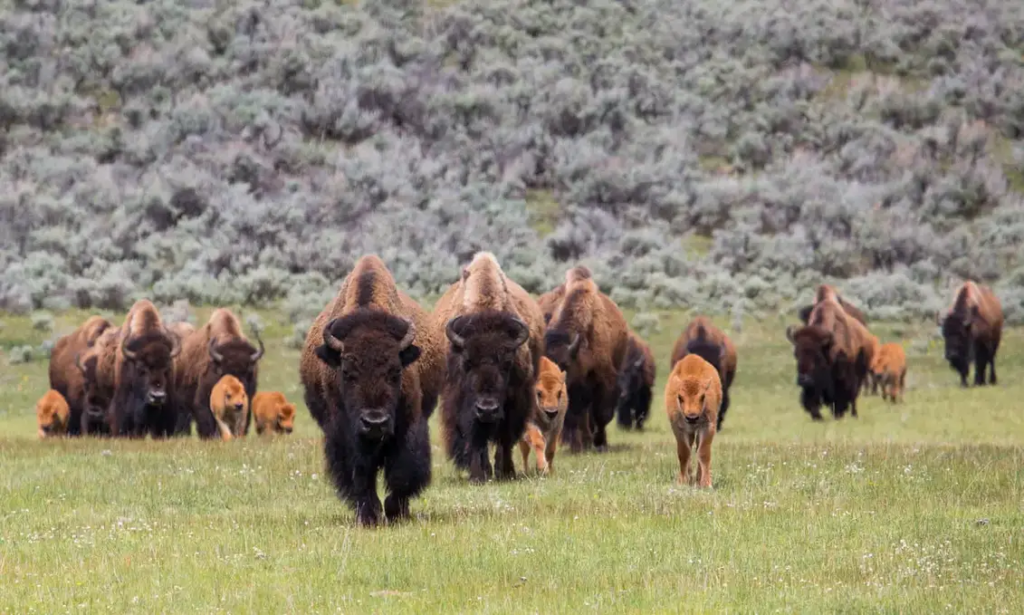How Native American Tribes Are Saving The Bison From Extinction
Millions of bison roamed the untamed north American regions a few hundreds of years ago. Unfortunately, the continent’s largest terrestrial mammals were on the verge of extinction. While there are only a few herds left in the country, most of which are in national parks and refuges, there is one location where a wild herd can still graze freely. The largest bison conservation herd lives on 12,000 acres of land in north-eastern Montana. According to the Guardian, some 350 people walk the tribal territories of the Assiniboine and Sioux tribes of the Fort Peck Reservation. These animals are important in the spiritual lives of the tribes. A role that, on the other hand, spared them from extinction. The indigenous peoples of North America made it their top goal to aid in the restoration of bison.

“Fort Peck was the first to stand up and say, ‘We want to help.’ We want to return these important bison to their historic Great Plains home,” said Jonathan Proctor, Rockies and Plains program director with NGO Defenders of Wildlife, who has joined the tribes’ efforts to bring the iconic animal back. And those concerned understood there was only one location to get wild, undomesticated bison: Yellowstone’s herd. The mission, however, was not without difficulty. The reason for this is because Yellowstone bison carry the disease brucellosis. The disease was first transmitted to Yellowstone bison by cattle in the early twentieth century, and ranchers and state officials are concerned about a resurgence.

Although scientists have never observed brucellosis transferring from bison to cattle, the Guardian speculated that it could be feasible. After 5 years, the efforts eventually paid off with the arrival of 60 animals. “There was a huge celebration; many, many members of the community showed up. It was thrilling to witness,” Proctor says. “We’ve seen the ecosystem come back to life. The grassland birds have returned, and the native grasses are flourishing. We appreciate and anticipate the buffalos’ future benefits to our tribal territory.” But that was just the start. Two years later, in 2014, thirteen indigenous nations signed the ‘Buffalo Treaty.’

“At the dialogues, we used to always have an empty chair for the buffalo, for the spirit of the buffalo.” It’s difficult to put into words, but the buffalo was basically saying, “You know, I’ve been gone for 150 years, why do you want me to come back?” stated Leroy Little Bear, a professor at the University of Lethbridge and a leader in the Blood Tribe’s bison restoration efforts. And the deal is already having an effect, with the Blackfeet Reservation in Montana receiving 89 genetically pure bison from Elk Island in Canada. Furthermore, the tribe is attempting to persuade authorities to let the bison to graze freely in Glacier National Park, territories that haven’t seen a bison in over a decade.

“Tribes of the northern plains are the lead in wild bison restoration right now. We’ll never see bison roaming the entire Great Plains again,” said Proctor. “We’ll never see 20 million to 30 million bison again. No one is trying to go back in time. We’re trying to go forward. We’re trying to restore this important animal where we can, where people want them, and to the level where they will help restore the natural balance,” Proctor added. However its’s amazing…with limited budgets and widespread poverty, Native American tribes are the leader in wildlife restoration.”

Related Posts
-
 Starving Bears That Spent Ten Years In Cramped Cage Take Their First Steps To Freedom
No Comments | Sep 26, 2023
Starving Bears That Spent Ten Years In Cramped Cage Take Their First Steps To Freedom
No Comments | Sep 26, 2023 -
 Baby Elephant Embraces Forest Officer After Reunited With Its Mother
No Comments | Oct 3, 2023
Baby Elephant Embraces Forest Officer After Reunited With Its Mother
No Comments | Oct 3, 2023 -
 A Well-Trained Horse Does An Amusing ‘Choreography’ To A Billy Ray Cyrus Song
No Comments | Aug 21, 2023
A Well-Trained Horse Does An Amusing ‘Choreography’ To A Billy Ray Cyrus Song
No Comments | Aug 21, 2023 -
 Loyal Cat Walks 12 Miles To See Family Again, But They Had Other Plans For Him
No Comments | Oct 1, 2023
Loyal Cat Walks 12 Miles To See Family Again, But They Had Other Plans For Him
No Comments | Oct 1, 2023
